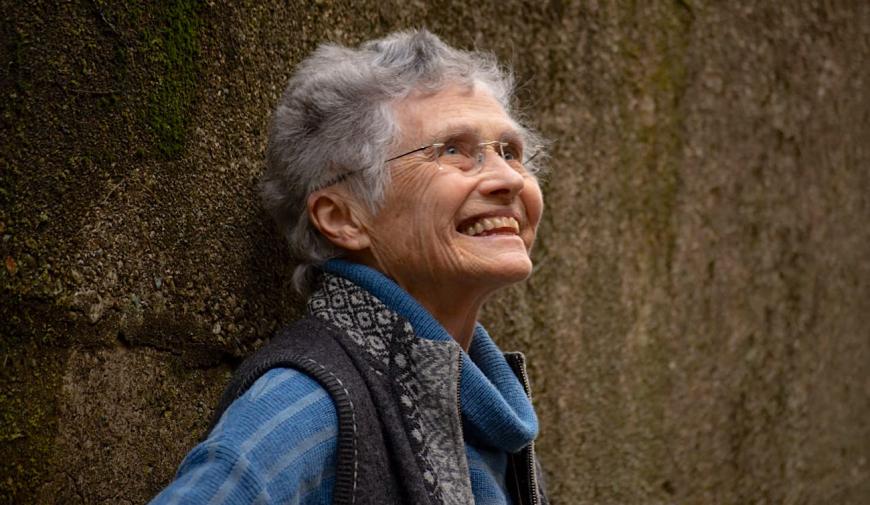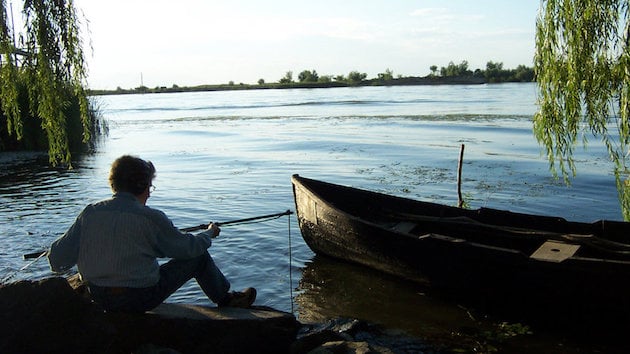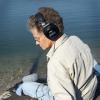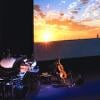
Experimental composer Annea Lockwood (b. 1939) has had a long career creating music that colors outside the lines. After her formal education, she began working with nontraditional instruments such as glass tubes and bottles and went on from there to encompass sound art and much else. She spoke with me surrounding her recent release on Black Truffle of a recording of her works Becoming Air, performed by trumpet player Nate Wooley, and Into the Vanishing Point, written for new music quartet Yarn/Wire. Her works stretch from taped “sound maps” of rivers (such as A Sound Map of the Danube, 2002-2005) to her loving arrangements of recordings of calls with her late wife, the composer Ruth Anderson. We dug into the sound of vulnerability, inducing atavistic memories, and her environmental works, including grieving for the disappearance of bugs.
Listening to Becoming Air [2018], there seems to be a focus on the sounds of the trumpet mouthpiece as well as the limits of what Nate [Wooley] himself can physically do. Do you have an interest in the way playing at the edge of ability produces its own kind of chance sound production? Is it an interest in the theatrical effect of watching someone perform at the edge of their ability, or is it more of an auditory interest for you?
Not so much theatrical as fully audio, but also in audio in such a way that the listener experiences what the player is experiencing within his or her own body. By sheer empathy you’re hooked up to the player’s body, as it were, and hear yourself going through those changes that I’m really interested in.
I’m sure it can feel like an exciting connection for an audience member, or for someone less experienced with more experimental work, it can be like watching someone on a tight rope.
Yes, which Nate translates as vulnerability, a player’s vulnerability. And that’s a really important aspect to both of us in our work in general, and certainly in Becoming Air. We had a conversation about this at length for Arcana, John Zorn’s publication, the most recent edition on precisely this topic. I’m interested in these highly collaborative compositions, and in [Becoming Air and Vanishing Point] I’m interested in being fully open, to where the musicians themselves, their train of exploration, which becomes a train of exploration for me. And Nate is interested in the experience of being on that tight rope as a performer, really open to the point of vulnerability. And both of us are fascinated by what happens when this scenario is in play, and the sound escapes the player’s control, then what happens to the sound? What does it become?
I was reading a passage in your interview with The Quietus, where you describe sound as having autonomy. Can you speak a little bit more to that?
Yeah! Sonic autonomy. A sound’s energy curves can be tightly controlled, but I’m less interested in that. [A sound] can be become unpredictable, and the timbral-spectral shape of a sound can change in the most wonderful ways, which one could not have thought up. And with the person producing the sound, the player’s own body is changing during that process, so it’s moving to watch. I find it very moving when players allow themselves to be that open and that vulnerable, as all the players on the record, as Yarn/Wire and Nate are. I find that a really moving generosity to observe, and then it’s fascinating to see where it goes.

I wanted to ask you, what is your relationship to mouth sounds? Because mouth sounds also fall in this intimate realm of vulnerability, but also a lot of people can’t stand hearing people eat, and they can feel embarrassing to hear or gross, or even sexual.
I need to take my mind back to when I first started working with Nate, whom I hadn’t met before he asked me to make a piece for him. And I did with him what I do with almost all the performers that I work with. I went to his place, and we use a little recorder, and I asked him what sounds he most loves to explore, not what sound he has perfected, but what he’s currently digging into exploring, and recorded them all. We talked and we discovered that we both resonated when sounds move out of control, as it were, with that process and experience. I took all of that home, and as I played it back, listening more and more intently, I realized that a sort of structural shape could emerge from it, which seemed very naturally to start with the mouth … The mouth seemed the obvious, the clear place to start. Besides, we were having a lot of fun exploring very, very delicate sounds.
Yeah, like the blowing across the mouthpiece.
Yes, and the whistle tones — which originated, I bet, with people blowing blades of grass. They’re ancient, those tones — and all sorts of delicate breath articulations and so on, which [Nate] does … And yes, I like [mouth sounds’] intimacy too, but I also like, in the intensity range we were working with at this point in the piece, I like the delicacy of them. Oh, you really have to listen to them closely, and in performance they really pull your ears in. There’s the tamtam stroke and then these sounds you can barely hear, and you can see that he’s doing something, but you can hardly hear the sounds at all. [It pushes] your hearing threshold so you can start hearing more and more.
It’s like tuning an audience.
Yeah. Precisely Yeah.
It’s interesting how there seems to be a confluence of the onset of greater ease in recording technology in the 20th century and increasing interest in Eastern traditions of meditation and mindfulness. It seems like a confluence of the ability to document sounds in one’s surroundings as well as the philosophy of becoming more mindful, simply noticing the things around you.
That convergence was the atmosphere, so to speak, when we were working in the ‘60s. And we were lucky; I mean it gave us, so many of us, the conviction that we could work, our work could move in any direction we wanted to explore, no matter what the materials. Or no matter what the aesthetic criteria. Just any direction, any way we wanted to move with whatever we wanted to use, which was so lucky. And it had been a while building, it didn’t come out of the blue, but it was an amazing ambience or environment in which to become composers, for people of my generation. And then it just kept on rolling, there was no turning back from it. So yes, that convergence you’re talking about emerged very easily, very smoothly and was very exciting, and is still emerging in so many ways.
You mentioned ancient sounds earlier, and considering your river mapping pieces, I wondered if in those pieces you were thinking about the sounds of earlier iterations of human life? Does imagining earlier humans’ auditory environment come into your work at all?
[In my river mapping pieces] I was really interested in the possible continuum of sounds and meanings from very early through, say, the early Middle Ages. And when I was making Tiger Balm [1970], I was in the middle of researching trance, and the connection between music patterning and sounds and trance. I was listening to a lot of recordings of trance rituals from around the world, or rituals in which, often, trance was induced, from the BBC archives, and was making programs on that topic for the BBC. And all of this sort of grew out of the connection between sound and the body and wanting to make that connection palpable. As musicians we are sort of responsible, we need to take responsibility for what you’re doing with people’s bodies.
So working on ritual and trance and investigating how much of the music is operative in changing participants’ states in trance rituals, that took me back to thinking about ancient sounds. Tiger Balm originated as a tape piece plus live sound-producing actions based on common elements I was finding in descriptions of the rituals I was listening to. Like feet running — just having their feet on a surface, not hard, just padding along, or sweeping [the floor] with a broom made of bamboo leaves to clear the spirit at the space. It’s a very common aspect of trance rituals, trying to clear the spirit world.
Spirit housekeeping.
Yeah! I did a piece called Spirit Catchers [1974], in which I was asking participants to bring to the performance some object which wasn’t necessarily intrinsically monetarily valuable, but which was immensely valuable in terms of their lives, which meant a lot to them, which was a sort of repository of feelings and experiences from their lives, and to just sit in front of a mic with them. [To sit] with a little object in their hands and just free associate, to talk about it as memories coming up and I would just pan around among the four microphones catching this one and that one and that one. Spirit Catchers catches old sounds.
I want to turn to the other piece on the album, Into the Vanishing Point [2019]. What the process was like, working with Yarn/Wire?
There’s somewhat of a similarity with the way I approached Nate, but more different. I approached Yarn/Wire, in that case, more abstractly. I knew that I wanted to co-compose it with them. I mean, they’re stunning musicians, very creative, and I really wanted to work with them in a space of complete openness. We needed a concrete starting point. With Nate, it was his sonic vocabulary and what he was currently interested in.
With Yarn/Wire, I had very recently read an alarming essay in The New York Times Magazine, by Brooke Jarvis called “The Insect Apocalypse [is Here].” And I’m concerned with environmental issues, as you probably gathered anyway, and that was an extremely alarming essay and it resonated with some of my experiences of driving around in New York and Montana and having to clean my windshield less and less frequently. So many fewer bugs. And I thought maybe it would be possible to take that as a starting point.
So I sent around an email to all of them, asking “would you each make your own personal vocabulary of soft sounds which you particularly like to work with and bring them to our meeting. It can be lengthy or not, the more sounds the better, like soil from which to work.” And they brought wonderful sounds, of course, as I thought they would. And my idea was that each of the four of them would develop this signature sound to identify with, which we could use through the piece. I also sent them the essay and it turned out, they’d all read it and they’d had the same reaction as I had to it, and we all wanted to work with it. So, I had suggested a structure with the initial section being one of proliferation. And these individual sounds coming up through four successive swarms of sounds.
Like mayflies.
Exactly. And in turn, moving into collapse of proliferation. And from that into what became mourning. When we did the first few meetings, and we would sort of work with one stage and then another, when we were working with “collapse” and were ready to move on from it, we suddenly realized that what we were actually creating was a rich piece of mourning. The ending, which still knocks me flat, I love it, which is an expression of grief, came from [pianist] Ning [Yu] bringing some foil and just holding it, close and crinkling it right under the mic, and the sounds were astonishing. What flashed into my mind was the breakup of the ice sheets and Antarctica, I mean, coming from New Zealand that is always in mind.
Did you talk to the performers of Yarn/Wire about whether the process of performing Into the Vanishing Point helped them with their own grief over the disappearance of insects and other animals?
I don’t recall specifically talking with them about that; I would be really curious to know that, actually. It seemed as if it was happening under us, because the sense of grieving became very strong, very clear. In their sounds, and the way their sounds were interacting with one another.
And again, this idea of the autonomy of sounds, the way that you just said the sounds interacted with each other, and how they have the ability to signal that it’s time to think about something difficult.
It’s energy; we’re releasing energy with every sound we’re creating. That energy has its own momentum, it’s got to go somewhere and that you can’t necessarily predict it is fascinating. And that’s so much more interesting to me than settling down with a sheet of score deciding what each player is going to do.
This is kind of a tangent, but I was reading about your recent piece For Ruth [2021], and, as a very queer composer myself, I was wondering if you feel like, through your career you have found a queer community within experimental music? It’s not directly talked about, but many important figures in experimental music, like Pauline Oliveros and John Cage, were queer. I was just curious if you if you feel like there was an acknowledged community, or a connection between being in the queer community and playing with glass bottles.
It’s important to me that we are in the community, in the new music community as lesbians, gays. Really, it’s important to me that it’s always been, and mind-blowing to me, and wonderful to me that back in the early ’70s, there was no question of acceptance. In the experimental music community, and experimental arts in general, no question [of acceptance].
I know a lot of [queer] people in the community, and some have been very close friends. Pauline, yes, an early and important friendship, but also Sorrel Hays, a composer from Georgia, a terrific composer who died about three years ago. And her partner, Marilyn Ries, who is a very good audio engineer, which was important, too, because [she] has been doing that all her life, and [was] starting at a point where when it was rare for a woman to be in the commercial audio engineering world … Ruth and I had a number of close friendships in the lesbian/ gay world. Before I met her, she had long known May Swenson, the poet. And, in fact one of Ruth’s most beautiful, funniest, nicest pieces is one that she and May recorded together, and May got very interested in sound recording and playing around with tape. And she did it very well [laughing] and she did it just as well as Ruth. She encountered Pat Highsmith, who she said was terrifying [laughing] — she didn’t know [who] she had just encountered, of course … But the ease with which Ruth’s and my partnership was accepted, taken for granted, was, was truly beautiful. I’ve always been grateful for how it kicked in so quickly.
Tying in with our conversation earlier about ancient sounds and trance ritual, your piece Thousand Years Dreaming [1990] draws inspiration from the cave art in Lascaux. For me, looking at cave art made by people from a time where, you know, there, there was such decreased mobility and yet, a similarity across the production of cave art that really feels like it’s hitting close to something very, very real to our animal selves.
Yeah, sure. One of my main purposes in including things like the running feet and blowing through brass plates and so on in the original version of Tiger Balm was because I wanted to see if those sounds might conjure faint memories in listeners’ minds, based on their antiquity. The question really was, do we hold atavistic memories of rituals, from way, way back within us? Are they there to be brought up into recognition, into awareness? And, of course, I never got an answer. But I was really, really curious [laughing] so I thought, well, we’ll make some of those sounds.
I think there are bodies of knowledge that go back to those very early eons of our existence, which would be invaluable to us now. Definitely as the world is beginning to shift all around us beyond our control. If we could just somehow let ourselves access that … While I’m used to fire season in Montana — Ruth and I built a house there, she was from there you know, she was a Montanan, she was really a Montanan [laughing] — Anyway the boys in the family inherited the two family cabins, so we built our own house, which took forever but was very satisfying. [Ruth] was really handy, but I had no experience in putting wood together. In any case, we would be there every summer. This summer fire season started in the beginning of July; a wildfire broke out within two miles of the house. Fortunately, it rained in time to bring the fires under some control, and it didn’t reach the house. That was terrifying, and I wonder if part of it was based on atavistic memory.
Yes, the smell of smoke, and a change of sky.
Yeah, you’ve got it, you nailed it.





